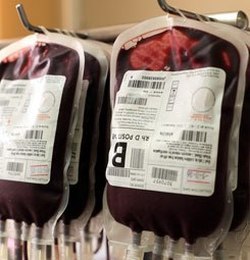|
~Iron Overload~ Author: Kara Martina, B. Sc Biopsychology Sickle Cell Patients often need blood transfusions as their own blood inadequately meets the body’s needs. These transfusions decrease early blood cell death, restrict endothelial damage and increase the blood’s oxygen carrying capacity. Transfusions for SCD patients prevent strokes and treat acute chest syndrome. Routinely administered and prescribed, blood transfusions deal with a range of additional SCD complications, such as priapism, vaso-occlusive crises, leg ulcers, pulmonary hypertension, and during complicated pregnancies (1). While transfusions have countless success stories, unfortunately a toxic side effect accompanies it: Iron overload.  Iron overload, the unavoidable complication of transfusions, leads researchers to hope for alternatives to this defaulted treatment. Although the relation between SCD patients and Iron overload needs further research, it has been suggested that Iron overload for those with SCD should not be underestimated (2), especially in those with chronic transfusions (3). With repeated transfusions, proteins in your plasma called serum transferrins become saturated with iron. The unwanted Iron, now called Non-Transferrin-Bound Serum Iron (NTBI) enters cells with high redox potential causing unwanted reactions which can eventually lead to organ damage (4). In other words, excess Iron causes excess free radicals that may kill your cells. For those with ß-thalassemia major, Iron overload can be lethal. For those with SCD, it should not be ignored. Symptoms range from tiredness and weight loss to heart failure and liver disease (5). To combat iron overload, drug options include Deferiprone, Deferoxamine, and Deferasirox. Proven to prevent organ failure and other complications, all three come with their prospective side effects. Deferiprone: Binds to Iron radicals. Commonly given in 500mg tablets. Side effects: Nausea, Chromaturia, and Abdominal Pain. May cause lethal agranulocytosis. Deferoxamine: Forms a stable complex with Iron. Also commonly given in 500mg tablets. Should not be taken with Vitamin C tablets . Side effects: Injections site reactions, abdominal pain, muscle spasms. Deferasirox: Reduces liver iron concentration and serum ferritin levels. Commonly given in either 125mg to 500mg tablets. Side effects: Serum creatinine increase, Abdominal pain, diarrhea, rash. May cause acute renal failure and death. All information was retrieved from the credible MedScape App available at http://itunes.apple.com or the App Store on your smart phone (6). Given the amount of drugs on the market and variability of each anemia case, this free App helps patients learn more about the drugs prescribed to them. Blood transfusions treat the side effects of SCD but further research on discovering less harmful iron chelation drugs would benefit the SCD community and anyone suffering from anemia.
References 1. Radha Raghupathy, Deepa Manwani, and Jane A. Little, “Iron Overload in Sickle Cell Disease,” Advances in Hematology, vol. 2010, Article ID 272940, 9 pages, 2010. doi:10.1155/2010/272940 2. E. B. Fung, P. Harmatz, M. Milet, et al., “Morbidity and mortality in chronically transfused subjects with Thalassemia and Sickle Cell Disease: a report from the multi-center study of iron overload,” American Journal of Hematology, vol. 82, no. 4, pp. 255–265, 2007. 3.Paul Harmatz, Ellen Butensky, Keith Quirolo, Roger Williams,Linda Ferrell, Thomas Moyer, Daniel Golden, Lynne Neumayr, Elliott Vichinsky., “Severity of iron overload in patients with sickle cell disease receiving chronic red blood cell transfusion therapy,” Blood Journal, 2000,96(1)76-79. 4. W. Breuer , Z. I. Cabantchik, B. P. Esposito, C. Hershko, P. Pootrakul and P. Sirankapracha, “Labile plasma iron in iron overload: redox activity and susceptibility to chelation,” Blood, vol. 102, no. 7, pp. 2670–2677, 2003. 5. Aplastic Anemia MDS International Foundation. (2011). Iron Chelation Therapy. Retrieved July 4, 2014 from http://www.aamds.org/node/82 6. WebMD Health Corporation (2012). Medscape (Version 4.0) [Mobile application Software]. Retrieved from http://itunes.apple.com
0 Comments
Leave a Reply. |
AboutThis section is solely to let our Sickle Soldiers tell their story trials & tribulations alongside things they feel are wrong in the Sickle Cell Community Archives
March 2016
Categories
All
|
 RSS Feed
RSS Feed
